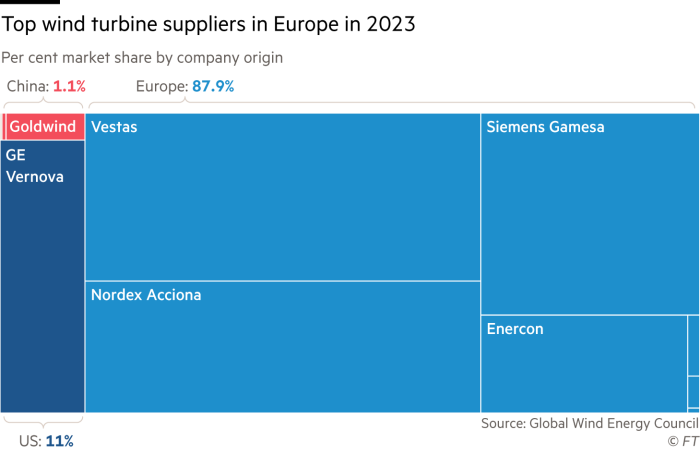Does Europe need Chinese wind technology to meet climate goals?
In northern Serbia, the development of one of Europe’s largest wind farms is a sign of the region’s efforts to meet clean energy goals. However, the decision to choose a Chinese company to supply the turbines shocked domestic opponents.
Some fear that Italy’s Fintel Energia using Zhejiang Windey to supply turbines for the Maestrale Ring wind farm is part of a growing trend that threatens to repeat the woes of Europe’s solar industry, where Chinese companies have reduced domestic groups in price, forcing many to fall.
Although Chinese producers account for only a fraction of Europe’s €57.2bn wind power market, Brussels has launched an investigation into whether Beijing groups are using unfair government subsidies to lower prices to create an opportunity for competition.
In April, the EU’s competition commissioner, Margrethe Vestager, accused China of repeating the “playbook” in the clean technology sector as a whole, including massive subsidies, which it has used to dominate the energy industry. of the day.
Pierre Tardieu, chief strategy officer at trade group WindEurope, which represents 550 renewable units in the region, fears a “situation” where Chinese companies will start to dominate the European turbine market, which is currently led by Denmark’s Vestas and Germany’s Nokia Gamesa.
“We strongly believe that this will be very bad news for the European air market and the European economy as a whole,” he added.

WindEurope, whose members include the region’s largest turbine makers, says Chinese manufacturers offer prices 40-50 percent higher than European rivals and allow manufacturers to defer payments. It argues that these prices are not possible without unfair public subsidies.
Last month, German property manager Luxcara selected Mingyang, China’s fourth-largest wind turbine manufacturer by market share by 2023, as its preferred turbine supplier for the project. imported air.
Holger Matthiesen, Luxcara’s project director, said the models were “the most powerful in the world” and the deal would help the company “accelerate Germany’s energy transition”.
In the UK, Swedish clean technology group Hexicon has also selected Mingyang as its preferred supplier for its proposed offshore wind project.
Some company executives believe that lower prices may prompt them to switch to Chinese suppliers.
“We don’t have Chinese turbines, but if prices stay at these levels, I think you will start to see more companies using them,” said Miguel Stilwell d’Andrade, EDP’s chief executive. of Portugal, which is 21 percent. of China’s Three Gorges Power Corporation. We will consider them again if they are more competitive.
Ignacio Galán, chief operating officer of Spanish utility Iberdrola, added that the company would like to focus on local suppliers, but if Chinese manufacturers “make reliable and competitive turbines, we will we are ready to consider them as potential suppliers”.

Additionally, analysts at Aegir Insights say a proposed 250-megawatt floating farm off the coast of Brittany, France, may not be possible without low-cost turbines, which would likely be Chinese or produced outside of Europe.
However, the Chinese have a long way to go to catch up with their European rivals. The main turbine manufacturers Goldwind and Windey accounted for only 1 percent of the market share in Europe last year, according to the Global Wind Energy Council (GWEC).
Mads Nipper, chief executive of Danish wind farm and solar farm operator Ørsted, played down concerns of a Chinese threat to domestic turbine manufacturers, telling the Financial Times earlier this year that there was it is unlikely that they can capture a large share of the market in Western Europe.
The China Trade Union of the EU (CCCEU) insists that “technological competition and strong competition, not state subsidies, drive the competitiveness of Chinese companies”. It also said the EU’s investigation into Chinese subsidies had caused “deep dissatisfaction and concern”.
China’s Zhejiang Windey backed the chamber, saying there were no “fair and transparent government subsidies”.
It added: “We also call for a fair, open and transparent air market without being manipulated by one party. We just want to contribute to the global energy revolution, with experience and our technology.”

The GWEC, which has Chinese companies including Zhejiang Windey and Mingyang among its members, agreed that maintaining “fair and transparent business practices” was important despite the measures introduced. by the EU to protect clean technology jobs against imports from Beijing.
The measures, which include an EU subsidy probe, have fueled concerns that without Chinese technology the region could miss its carbon emissions targets. The EU has set tough climate targets which it estimates could cost €1.5tn a year in investment.
“If we in Europe follow the plan of repatriation, with the importation of foreign space and the aim of local production, we may risk [ . . .] delaying the transfer of energy in Europe as everything would cost a little more,” said Simone Tagliapietra, a senior figure at the Bruegel think tank.
“Instead of defying gravity and defeating the Chinese or trying to compete with the Chinese with the economies of scale they’ve built, we’d be better off focusing on an innovation-driven industrial strategy.”
Jonathan Cole, chairman of GWEC but speaking in his capacity as chief wind development manager of Corio Generation, agreed. Shutting out Chinese businesses in the global supply chain would “significantly hinder” the ability to achieve decarbonisation goals, he said.

“A good fiscal policy designed to stimulate the growth of local supply chains may help achieve our goals more than a policy aimed at discouraging or marginalizing foreign suppliers,” he said. added to say.
Some European politicians are also warning against more barriers to Chinese companies. “We want cheap and fast and local production. We can only have two of those three. We need to make a wise choice,” said the EU’s top diplomat.
Climate Capital

Where climate change meets business, markets and politics. Check out the FT news here.
Curious about FT’s commitment to the environment? Find out more about our science-based goals here
#Europe #Chinese #wind #technology #meet #climate #goals
